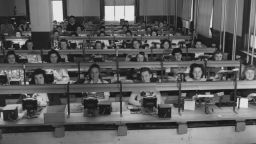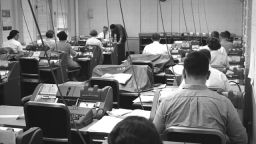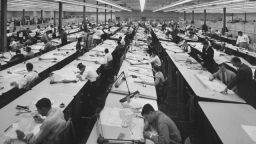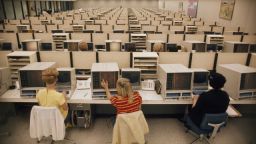Story highlights
Offices are often regimented workspaces, allow for little creativity
The most creative offices allow people of different personalities, disciplines to mix
Office furniture companies are looking to the "human-centered," high-tech future
But creativity is a work in progress in a short-term world
Offices often aren’t the best places to work.
If you’re like most members of the Great American Labor Force, at this very moment you’re probably sitting in a cramped cubicle, listening to your neighbor clip his toenails while you scarf down a pizza slice on your “lunch hour,” awaiting a meeting in which three of the 17 people invited will dominate the conversation and follow with a flurry of e-mails, instant messages and requests for conference calls.
Work? How can you even think with all this noise?
And yet, the office – yes, the one with the cubes and the conference rooms and the allegedly efficient flow of communication and ideas – was supposed to set you free. At least to do your job, anyway.
In 1968, the business furniture company Herman Miller introduced the “Action Office.” It was meant to be an antidote to the desk rows and walled offices then in vogue, the kind you see in old black-and-white movies. It was going to be the office of the future, the kind of place where you could really get things done.
In a manifesto, Action Office designer Robert Propst railed against “our information deluge” and complained about the office’s sedentary nature – “the result (of sitting), as medical studies and insurance data make clear, is a steady decline in vitality, energy and general body tone,” he said. His new idea: an environment that would create a healthy balance between collaboration and privacy, and promote variety over gridlike formality.
Sound familiar?

Unfortunately for all us cubicle dwellers, most of Propst’s Action Office ideas were ignored. Action Office had desks of varying heights, community areas and expansive work surfaces, at a time when the only desk-bound technology might have been a phone and an adding machine. (Computers, of course, were so large they filled separate rooms in 1968.) It was the partitions that became the selling point, and consequently we ended up with the rabbit warrens that dominate offices today. Propst ended up a foe of Action Office – or, at least, the way it was used.
An office doesn’t dictate creativity, of course. Generating ideas, cross-fertilizing those concepts with others, having the time to work through the ideas’ possibilities, transmitting them to the wider world where the process will continue – they’re all part of a complex dance of individual capabilities, group dynamics and corporate cultures
But key to its success is an atmosphere, both physical and psychological, that allows people to be at their sharpest.
Creativity is a huge topic in the business world, which wants to tap into the energy of a million light bulbs.
Just listen to the buzzwords that get reduced to meaninglessness: “Ideate.” “Synergize.” “Holistic.” “Intellectual capital.” “Outside the box.” “Work smarter, not harder.” Or read the books: “The Business Playground.” “The Progress Principle.” “The Rudolph Factor.” “The Firefly Effect.” “Out of Our Minds: Learning to Be Creative.”
And yet too often creativity is stifled rather than encouraged. To paraphrase the old saying about weather, everybody talks about corporate creativity … and everybody talks about corporate creativity. No wonder so many people tape “Dilbert” strips to their screens, or repeat lines from the film “Office Space.”
There’s a lot of truth to the complaints about the corporate mind-set, says Teresa Amabile, a Harvard Business School professor who teaches a course in business and creativity.
“There’s often a lot more constraint, there’s often a dismissal of new ideas inside business organizations,” she says, adding that “doing creative work inside organizations can certainly be more challenging than doing creative work on your own.”
But still, she adds, an office can be an engine for creativity – if tuned correctly.
“There can be a lot of stimulation in working with other people, especially if they have different backgrounds, different perspectives, if they come from different disciplines,” she says. “That can actually spark ideas, as long as people can effectively communicate. And it can be more fun to do creative work with others.”
‘Work together, or we fail alone’
But how do you accommodate the idiosyncrasies of so many “others”?
It’s hard enough getting people to understand one another across departments. It’s an even bigger challenge when they’re of different personalities.
Creativity doesn’t always call attention to itself. Susan Cain, author of the recent book “Quiet” – which is subtitled “The Power of Introverts in a World That Can’t Stop Talking” – observes that creative people are often inclined to solitude and often don’t speak up in the meeting-room situations that dominate many corporate settings. And don’t even think of brainstorming: Studies have continually shown that it doesn’t work. (Incidentally, being introverted isn’t the same thing as being shy or misanthropic: Introverts may prefer less stimulation, but they still may have strong social skills.)
Susan Cain’s TED Talk: Introverts run the world

Moreover, we live in a world where the cultural ideal is that of the extrovert – the ebullient type who thrives on public exposure. As Cain observes in her book, business has honored the extrovert at least since the days of Dale Carnegie, whose “How to Win Friends and Influence People” has been a best-seller since it was first published in 1936. Even Jesus wasn’t immune: Eleven years before Carnegie, the advertising executive Bruce Barton published “The Man Nobody Knows,” which portrayed the Son of God as “the world’s greatest business executive” in part because of his salesmanship abilities.
And yet there’s much to be gained from the qualities of introversion, Cain points out. Introverts are comfortable with time alone. They tend to work more deliberately and with greater concentration. Socially, they enjoy small groups and listen more than they talk.
So offices need to bridge gaps between extroverts and introverts. And the best examples of creative workplaces find ways to do so.
“Especially in this day and age, there’s good evidence that our problems are getting harder,” says Jonah Lehrer, author of the new book “Imagine: How Creativity Works.”
“We have to learn how to work together, or we fail alone.”
Listen to Lehrer talk about “Imagine”
For his book Lehrer spent time at Pixar, the award-winning animation studio. Pixar’s headquarters near Oakland, California, features an atrium lobby that contains the building’s mailboxes, cafeteria and even the bathrooms, the design the brainchild of Steve Jobs, who bought the company in 1986. Everybody has to come through the atrium, which forces people of all types – and from all disciplines – to mix, mingle and exchange ideas.
“The atrium initially might seem like a waste of space,” “The Incredibles” director Brad Bird told Lehrer. “But Steve realized that when people run into each other, when they make eye contact, things happen. So he made it impossible for you not to run into the rest of the company.”
The same ethos has ruled at some notable innovation shops. As Jon Gertner details in his book “The Idea Factory,” when Bell Labs – one of the great pioneers in business and engineering, where the integrated circuit and the telecommunications satellite were invented – designed a new campus in northern New Jersey, head man Mervin Kelly created interdisciplinary groups from a variety of sciences.
The groups also featured a variety of personalities; one unit paired the aggressive, outgoing physicist William Shockley with the pensive electrical engineer John Bardeen. Along with Walter Brattain, the two won the 1956 Nobel Prize in Physics for their invention of the transistor.
Bell Labs also had the right mind-set for creativity: patient, curious and willing to fail. As one metallurgist put it, “A research man is endlessly searching to find a use for something that has no use.”
John Seely Brown, who oversaw another innovative laboratory, Xerox’s PARC – the birthplace of the computer mouse and the laser printer – says putting people with a variety of interests in close proximity was key to the lab’s success.
“We all ate together. We had long tables in the dining room, purposely designed so you were constantly eating with other fields,” he says. “At lunch we were mixing it up all the time, at coffee mixing it up all the time. We were constantly talking with each other, but with different lenses on.”
‘Ideas are fragile’
Office designers have gotten the message. In fact, they’ve become evangelists for it.
“More and more, we’re able to say there’s a lot of value being lost in the (standardized) model,” says Greg Parsons, Herman Miller’s vice president of landscape environments. “Standardizing everything isn’t necessarily the way to generate creativity.”

More than 40 years after the cube took over, Herman Miller’s rival Steelcase has created what it calls “human-centered design.” Part of that, says Steelcase design director Brett Kincaid, is allowing inspiration to breathe.
“Ideas are fragile,” he says.
Steelcase has its own version of PARC’s dining room – one that refines the idea beyond long tables and ad hoc lunch discussions.
At its Grand Rapids, Michigan, headquarters, the bottom floor is dominated by the WorkCafe. The area used to be a warren of basement conference rooms but has been renovated into a round-the-clock haven for workers to meet and eat – or get away from their own offices and cubes for a while to work and think.
The WorkCafe is expansive and welcoming, with zippy touches – a bit of artwork here, a gleam of stainless steel there – and bright lighting. The layout flows smoothly, with spots for small groups over here, large contingents over there, and quiet and solitary individuals around a corner. Walk down a broad staircase from the lobby and take your pick of settings, or go from one to the other.
Parts of it evoke a futuristic gathering spot, with blond wood, white tables, orange stools and small, sleek high-tech pods, complete with what Steelcase calls “Pucks” – plug-in devices for laptops and gizmos. Another area is more conventional, like the counters and seats of a classic diner, though it’s given an artsy tinge thanks to a tall, gleaming sculpture engraved with Steelcase patent numbers. Farther away, there’s a cozy, librarylike quarter, with bookshelves, upholstered seats and small tables, perfect for solitary thinking over a cup of coffee.
Surrounding it all are conference rooms of various shapes and sizes, complete with cameras, large-screen monitors, information displays (on touchscreen tablets) and small alcoves for gathering your thoughts – or information. It’s all accommodating to mobile technology, since many of us don’t have to stay glued to our desks anymore.
The WorkCafe, which opened in November, was intended to encourage communication, thinking and creativity – and, based on the constant flow of employees visiting throughout the day, it appears to have succeeded in its task.
“Employees are choosing to meet here, and not just because there’s a good latte,” says James Ludwig, Steelcase design vice president. “It’s a place to escape to work, instead of escape from work.”
It’s also taken cues from some of the ideas designers have already put into place in the company’s upstairs offices, including nods to mobility and work-life balance.
“This project allowed us to say, here are the trends we’re seeing – and how we ourselves want to work, and where we see the future of work is going,” says design manager Cherie Johnson.
That’s a philosophy worth following, adds Frank Graziano, a researcher with the company. He observes that offices tend to have “knowledge flows,” “gatekeepers” and “hubs,” and if you’re aware of those dynamics, you can shape the physical space accordingly. Understanding office dynamics means learning to understand individual employees, and where they stand in the overall environment, he says.
Moreover, it’s not like most workers do the same thing all the time, or that each department is one-size-fits-all. There are microcultures and varying work styles, and different work modes people adopt depending on a situation, says designer Julie Barnhart Hoffman. These include quiet-focused work, socialization with feedback, collaboration and learning. The company builds spaces to accommodate each of those work modes; after all, Steelcase doesn’t just make office environments for others.
“We’re testing our own ideas,” Hoffman says. “We’re kind of our own customer.”
Bottom lines
The needs of people and the needs of the company are at the crux of the issues facing corporate creativity. Creativity requires give-and-take, communication, thoughtful critiques and alone time. But, all too often, ideas fall between departmental silos or get caught up in corporate politics.

Then there’s the bottom line. Companies can’t just accommodate their employees; there are stockholders, analysts, the whole outside world less concerned with worker contentment than a healthy dose of profits.
“Within organizations, there are different objectives,” says Jill Perry-Smith, a professor at Emory University’s Goizueta Business School who has studied the effect of informal social networks on creativity. “In many cases, some of the systems that produce effective organizations simultaneously may hamper creativity within those firms.”
Moreover, creativity – with the promise of newness embedded in its very core (“creative” implies something novel and different) – presents a risk to the way things have always been done.
So it’s a work in progress. America remains a bottom line-oriented culture, more comfortable with doers than thinkers, wary of unorthodox arrangements and nonconformity. But things are changing, whether our offices are ready for it or not. If there’s a message to all those books, all those buzzwords, all that cheese-moving, it’s this: If you want to improve creativity, you have to be ready to adjust.
What works, researchers have determined, is moderation: a mix of personalities and disciplines able to discuss and critique ideas in a variety of settings. We can hang out in coffee shops. We can use our Wi-Fi-equipped tablets. We can meet in small groups or conference with people half a world away.
We may still have to work, but we’re not going to be chained to a cube.
“People know when they’re given choice and when they’re being forced into a behavior,” says Steelcase’s Ludwig. “What I love about American business culture is the innovative ways people find to get what they need and do things their way.”
So the furniture can help, but it’s only as effective as the people who know how to use it. Ponder that the next time you’re sitting in your cube.
How do you nurture your creativity in the workplace? Let us know in the comments below.










